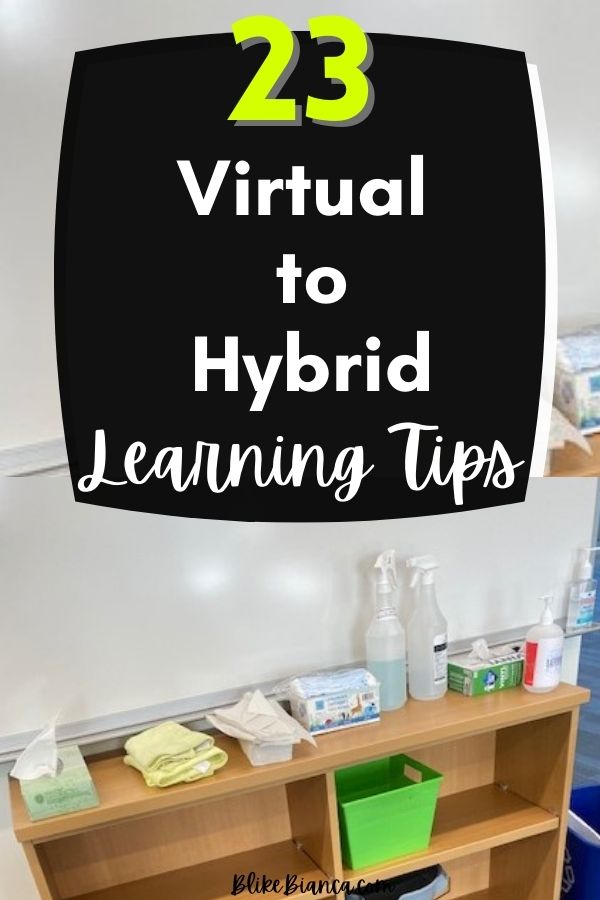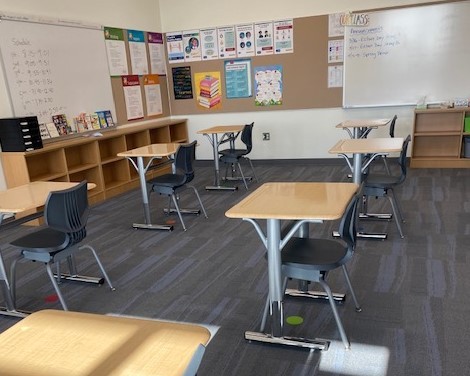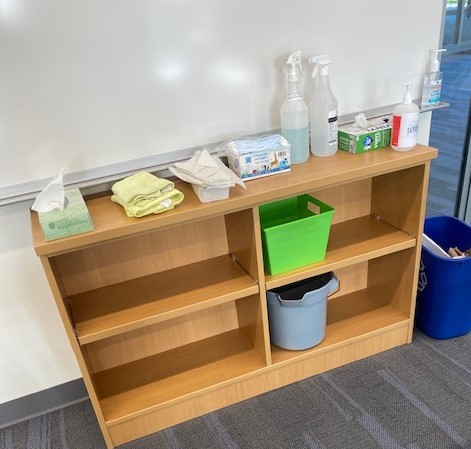Hybrid learning is new to many teachers but it’s something that is now part of normal education. After a year of at-home distance learning, many districts are starting to easy back into the in-classroom traditional setting. With a little over a week of hybrid teaching experience, I think I have a routine that works.
Here’s a little back story. I live in one of the first states to go into, at first- a 6-week shutdown (that eventually became a lot longer than expected), I was in a district that was nowhere near prepared for an online format. For 2 weeks, teachers and students were in limbo while the district needed to get students laptops and teachers trained on an online teaching platform.
Now, about a year ago today, I’ve been reflecting on the disruption of everyone in their school, work, home, family, and social lives. Most importantly wondering why so many school districts weren’t prepared. While many districts have schools with mission statements and visions that focus on preparing students for a global world, where technology is the base of the inevitable future. But it was all hands on digital teaching and learning from a pandemic induced shutdown that helped teachers across the country prepare, the best we can for a hybrid transition.

What is hybrid learning?
According to Panaramaed.com, hybrid learning combines face-to-face instruction with online learning. In the context of coronavirus school re-openings, a hybrid model would reduce the number of students in the building by moving some of the course delivery online. You may also refer to it as blending learning but for many the structure remains the same, it is learning that is a collaboration of in-person and online learning interaction.
Hybrid learning examples?
Currently in the district that I teach in our hybrid learning model allows students to come to in-person learning twice a week. They are broken into an A group and B group with A group coming on Tuesdays and Thursdays and B group on Wednesdays and Fridays. Monday are online learning for the entire school. For student’s off days, they have asynchronous learning where they complete assignments they started in-school.
We do also have a group of students that are online only. Their parents wanted to maintain the online learning environment for them so the school district made that an option. These students come to a Zoom classes on Tuesdays and Thursdays and have asynchronous learning on their off-Zoom class days.

How I teach in a hybrid format
Teaching in a hybrid format varies from district to district and even varies by teacher. I try to keep the same model format that I did when my students were completely online. I think this is not just easier for them but easier for me so it doesn’t create more work.
Every Monday and Wednesday, I create the lessons for the week. I created using a PowerPoint or Google Slides presentation and I deliver the lesson in my Zoom class and in my in-person class. I give students the last 15 minutes of their time with me to start working on their assignment.
At the end of the day, I record my voice teaching the lesson again for students that need extra clarification and I upload any other related materials so students can go back and watch if needed. This also helps for students that are absent because I can refer them back to the date they were absent to watch the instructional materials.
What my Google Classroom Stream looks like:

I also set up office hours to meet with students on Mondays, Wednesdays, and Fridays where I invite them to meet with me on Zoom. Usually this is for students who may be struggling with either in-person or Zoom learning.
Top Tips for Hybrid Learning:
From wearing a mask, keeping everything sanitized, to maintain self-care…
- Have multiple masks on hand either cloth, KN95, or one-time use masks.
- Make sure to have properly fitted masks for you and your students.
- Don’t wear the same mask 2 days in a row and try not to bring one from home.
- Don’t touch your mask, if you do, sanitize!
- Keep a “clean corner” of your classroom for hand sanitizer, extra masks, gloves, cleaning solution, paper towels, etc.

- Have hand sanitizer in multiple places in the room for easy access.
- Take a few minutes at the end of class to wipe down tables and chairs
- If possible, take time to briefly open classroom windows.
- Keep a bottle of lotion nearby and encourage your students to do the same.
- Change clothes when you get home or be open to wearing a lab coat.
- Focus on one daily learning objective
- Limit grading assignments to just 1-2 a week.
- Give students grace
- Keeping working on relationship building with your students, even more so during this time.
- Do self-care check-ins with students at the beginning of class and with yourself!
- Continue using technology or limit paper worksheets to once a week.
- Try using Google Forms for attendance and check-ins.
- Have some daily built in free-time for the last 5 minutes of class or mini-breaks throughout the day, for yourself and the students.
- Encourage students to have their own water bottles or have mini cups for them to use.
- Disinfectant spray is quick and easy to use and it last a long time!
- Have a bathroom signal for students, this will stop having students get out of their seat to ask you to use the bathroom.
- Remind students where their personal space is. Without realizing, students will get up and go to another student’s desk to talk.
- Try not to isolate yourself. It seems natural after doing so for 12 months but check-in with your neighbor teachers.
Final Thoughts
This list could have continued and I would like to add more, especially since it is a learn as you go experience. Overall, being flexible during this transition time is the most important. Give yourself, students, co-workers, and families grace and in another year, hopefully we can find some normalcy.
Always remember to practice self-care strategies, check out how to create a self-care plan and how to get a free self-care kit, check it out here!
If you have a suggestion for the list please add in the comment area below!
